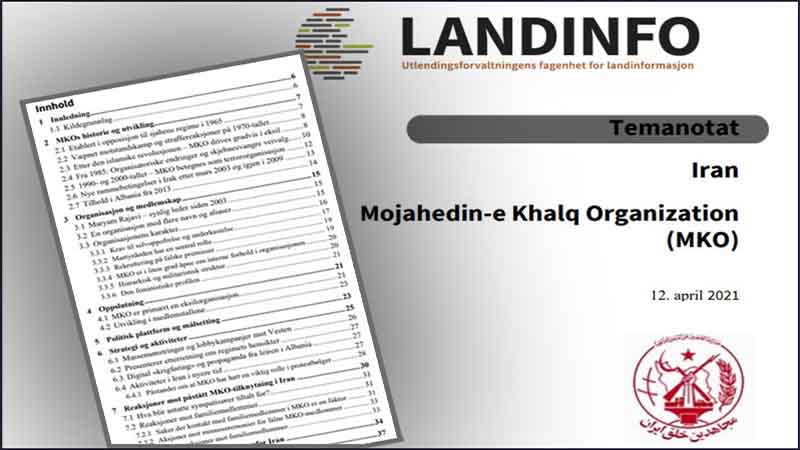“MKO has a very visible public profile, but is not a transparent organization”, according to Landinfo report of Norway.
Landinfo is a Norwegian Institute that published a 45-page study on the Mujahedin Khalq Organization (MKO/ MEK/ PMOI/ Cult of Rajavi) in April 2021. The paper which is seemingly prepared for the Norwegian Immigration Authorities is based on various sources. However, the authors assert that they tried to choose the most reliable independent sources on the topic. “What is MKO’s inner character is a controversial question”, they write. “It has therefore been important to build the presentation of this topic as independently as possible. The information on internal matters in MKO is partly based on reports published by human rights organizations and Western media, and partly on observations from various sources in MKO’s camp in Iraq”.
Therefore, the paper lists certain sources as the references on what is really going on in the MKO:
• In 2005, Human Rights Watch published the report “No Exit. Human Rights Abuses Inside the MKO Camps », based on interviews with twelve former MKO members who then resided in European countries (HRW 2005).
• A large number of media have interviewed defectors who are in Europe – for example The Guardian (Merat 2018), New York Times (Kingsley 2019), BBC News (Pressly & Kasapi 2019), The Intercept (Hussain & Cole 2020b) and Dagens Næringsliv (Engdal 2019a & b).
• The UN operation in Iraq, UNAMI, had access to the camps in Iraq after Saddam Hussein’s regime was overthrown in 2003. UNAMI had a monitoring and broker role, and have reported on what they observed in human rights reports for Iraq (UNAMI 2013, 2011 and 2009).
• At the request of the US government, the think tank RAND Corporations prepared a report on MKO in 2009. The report is based on interviews in MKO’s Camp Ashraf in Iraq (Goulka et al. 2009).
• In 2003 and 2020, the New York Times received permission to visit MKO’s camps in Iraq (Rubin 2003) and Albania (Kingsley 2020), respectively.
Based on the above-mentioned sources, in a part subtitled “Nature of the organization”, Landinfo describes the MKO with the characteristics of “an authoritarian, cult-like organization, which strictly controls its members”. These characteristics are enumerated by the authors as the followings:
Requirements for self-sacrifice and submission
members must sign a contract where they commit to sacrifice everything in the battle to defeat the enemy. That means that they must do whatever the organization requires them to do.
Person worship
It is claimed that the ideology centers around a cult of personality, in which the members must show leaders unreserved devotion and submission, almost a form for religious worship. The informal title Imam Zaman should have been used for Massoud Rajavi, and the actual membership ceremony continues allegedly in taking an oath of allegiance to the leaders.

Ideological indoctrination
The indoctrination allegedly takes place through a mixture of propaganda and fear tactics. It is pointed out that the members must regularly study MKO’s ideology and see recordings of Massoud Rajavi’s speeches and various street demonstrations in Europe.

Sexual control and emotional isolation
Some of the things that members have to give up are family life and romance relationships. The camps are gender segregated, and married couples have reportedly had to divorce and live apart in complete celibacy. Personal friendships should also be strongly discouraged. The love of the members shall, instead, be channeled towards MKO’s leaders

Degrading confessions of unwanted thoughts and feelings
To check the members’ dedication to the movement, it is claimed that men and women must attend ritual self-examination meetings. Here they must openly confess and apologize impure thoughts, personal dreams, disloyal tendencies and character flaws.

Physical abuse, deprivation of liberty
Those who have asked to leave the group must have been put on isolation for long periods, and have been subjected to mental and / or physical abuse. Other unfair and unacceptable behavior that must also have been punished by the leaders are: expressing or encourage disagreement with MKO’s strategy, listening to foreign radio stations, sharing individual political views with other members, or making private phone calls.


Hard work and sleep deprivation
At MKO’s camps, residents often have to work 16-17 hours a day, with one limited number of hours of sleep. Continuous construction projects are implemented to maintain a high work intensity, in addition to military training.

Martyrdom has a central role
The members and sympathizers who have lost their lives in the fight against the Iranian government, honored as martyrs. MKO even claims that it is about 120,000 persons. The worship of martyrdom and the degree of devotion of some members to MKO leadership, became visible to the world in 2003, when French police arrested Maryam Rajavi in Paris. In protest, ten MKO members and sympathizers set themselves on fire in different European cities, and two of them died. It was also arranged hunger strikes. Pictures of people who had sewn together their eyes and lips was published in western media.
Recruitment on false premises
The movement that managed to mobilize half a million people for mass protests in June 1981, has had a deficit of volunteer recruits since the end of the Iran-Iraq war. This should have led the group to recruit new members with dishonest premises. Iranians were allegedly lured to Iraq with false promises of property, work, marriage and help to seek asylum in the West. Recruitment agents must have sought out Iranian dissidents in particular, but also addressed economic migrants in countries such as Turkey and the United Arab Emirates. Others reported methods were to smuggle family members out of Iran to visit relatives in the camps, or pay human traffickers to redirect people who were on the run, to Iraq.
by Mazda Parsi

